Integrating System Perspectives to Optimize Ecosystem Service Provision in Urban Ecological Development
Abstract
1. Introduction
2. Materials and Methods
2.1. Study Area
2.2. Data Collection
2.3. Ecosystem Service Evaluation and Valuation
2.4. Driver Analysis
2.5. Identification and Delineation of Enhanced-Efficiency Ecosystem Service Management Region
3. Results
3.1. Spatiotemporal Heterogeneity of Ecosystem Services
3.1.1. Water Conservation
3.1.2. Stormwater Runoff Regulation
3.1.3. Carbon Dioxide Sequestration
3.1.4. Reduction of Sedimentation
3.1.5. Reduction of Non-Point Source Pollution
3.2. Identifying Suitable Cropland Landscape Patches for Priority Conservation
3.3. Enhanced-Efficiency Ecosystem Service Management Region Identification and Delineation
4. Discussion
4.1. Urbanization and Ecosystem Service Degradation
4.2. An Integrated System Approach to Optimizing Ecosystem Services
4.3. Identifying Key Drivers for Enhanced-Efficiency Ecosystem Service Management Region
4.4. Potential of Enhanced-Efficiency Ecosystem Service Management Region in Ecological Restoration
4.5. Revolutionizing Planning with Systems Science for Sustainable Ecosystem Services
4.6. Limitations and Prospects
5. Conclusions
Supplementary Materials
Author Contributions
Funding
Data Availability Statement
Conflicts of Interest
References
- Brauman, K.A.; Garibaldi, L.A.; Polasky, S.; Aumeeruddy-Thomas, Y.; Brancalion, P.H.S.; DeClerck, F.; Jacob, U.; Mastrangelo, M.E.; Nkongolo, N.V.; Palang, H.; et al. Global trends in nature’s contributions to people. Proc. Natl. Acad. Sci. USA 2020, 117, 32799–32805. [Google Scholar] [CrossRef] [PubMed]
- Costanza, R.; d’Arge, R.; de Groot, R.; Farber, S.; Grasso, M.; Hannon, B.; Limburg, K.; Naeem, S.; O’Neill, R.V.; Paruelo, J.; et al. The value of the world’s ecosystem services and natural capital. Nature 1997, 387, 253–260. [Google Scholar] [CrossRef]
- Liu, Y.X.; Fu, B.J.; Wang, S.; Rhodes, J.R.; Li, Y.; Zhao, W.W.; Li, C.J.; Zhou, S.; Wang, C.X. Global assessment of nature’s contributions to people. Sci. Bull. 2023, 68, 424–435. [Google Scholar] [CrossRef] [PubMed]
- Xu, Z.; Ma, J.; Zheng, H.; Wang, L.; Ying, L.; Li, R.; Yang, Y. Quantification of the flood mitigation ecosystem service by coupling hydrological and hydrodynamic models. Ecosyst. Serv. 2024, 68, 101640. [Google Scholar] [CrossRef]
- Yang, D.; Luan, W.-X.; Zhang, X. Projecting spatial interactions between global population and land use changes in the 21st century. npj Urban Sustain. 2023, 3, 53. [Google Scholar] [CrossRef]
- Soni, H.; Yadav, R.K.; Patra, S.K. Global impact of urbanization on ecosystems: A comprehensive bibliometric analysis. Nat. Hazards Res. 2024. [Google Scholar] [CrossRef]
- Weiskopf, S.R.; Rubenstein, M.A.; Crozier, L.G.; Gaichas, S.; Griffis, R.; Halofsky, J.E.; Hyde, K.J.W.; Morelli, T.L.; Morisette, J.T.; Muñoz, R.C.; et al. Climate change effects on biodiversity, ecosystems, ecosystem services, and natural resource management in the United States. Sci. Total Environ. 2020, 733, 137782. [Google Scholar] [CrossRef]
- Trégarot, E.; D’Olivo, J.P.; Botelho, A.Z.; Cabrito, A.; Cardoso, G.O.; Casal, G.; Cornet, C.C.; Cragg, S.M.; Degia, A.K.; Fredriksen, S.; et al. Effects of climate change on marine coastal ecosystems—A review to guide research and management. Biol. Conserv. 2024, 289, 110394. [Google Scholar] [CrossRef]
- Sieber, I.M.; Campagne, C.S.; Villien, C.; Burkhard, B. Mapping and assessing ecosystems and their services: A comparative approach to ecosystem service supply in Suriname and French Guiana. Ecosyst. People 2021, 17, 148–164. [Google Scholar] [CrossRef]
- Costanza, R. Valuing natural capital and ecosystem services toward the goals of efficiency, fairness, and sustainability. Ecosyst. Serv. 2020, 43, 101096. [Google Scholar] [CrossRef]
- Rendon, P.; Steinhoff-Knopp, B.; Burkhard, B. Linking ecosystem condition and ecosystem services: A methodological approach applied to European agroecosystems. Ecosyst. Serv. 2022, 53, 16. [Google Scholar] [CrossRef]
- Khosravi Mashizi, A.; Sharafatmandrad, M. Investigating tradeoffs between supply, use and demand of ecosystem services and their effective drivers for sustainable environmental management. J. Environ. Manag. 2021, 289, 112534. [Google Scholar] [CrossRef]
- Zhou, A.; Zhao, W.W.; Pereira, P. Mapping and assessing freshwater ecosystem services supply and demand in Inner Mongolia (China). Landsc. Ecol. 2023, 38, 1885–1902. [Google Scholar] [CrossRef]
- Wang, L.-J.; Ma, S.; Jiang, J.; Zhao, Y.-G.; Zhang, J.-C. Spatiotemporal Variation in Ecosystem Services and Their Drivers among Different Landscape Heterogeneity Units and Terrain Gradients in the Southern Hill and Mountain Belt, China. Remote Sens. 2021, 13, 1375. [Google Scholar] [CrossRef]
- Proctor, J.; Rigden, A.; Chan, D.; Huybers, P. More accurate specification of water supply shows its importance for global crop production. Nat. Food 2022, 3, 753–763. [Google Scholar] [CrossRef] [PubMed]
- Rosińska, W.; Jurasz, J.; Przestrzelska, K.; Wartalska, K.; Kaźmierczak, B. Climate change’s ripple effect on water supply systems and the water-energy nexus—A review. Water Resour. Ind. 2024, 32, 100266. [Google Scholar] [CrossRef]
- Konapala, G.; Mishra, A.K.; Wada, Y.; Mann, M.E. Climate change will affect global water availability through compounding changes in seasonal precipitation and evaporation. Nat. Commun. 2020, 11, 3044. [Google Scholar] [CrossRef]
- Peng, Y.; Chen, W.; Pan, S.; Gu, T.; Zeng, J. Identifying the driving forces of global ecosystem services balance, 2000–2020. J. Clean. Prod. 2023, 426, 139019. [Google Scholar] [CrossRef]
- Li, W.; Li, X.; Zhao, Y.; Zheng, S.; Bai, Y. Ecosystem structure, functioning and stability under climate change and grazing in grasslands: Current status and future prospects. Curr. Opin. Environ. Sustain. 2018, 33, 124–135. [Google Scholar] [CrossRef]
- Grimm, N.; Chapin Iii, F.S.; Bierwagen, B.; Gonzalez, P.; Groffman, P.; Luo, Y.; Melton, F.; Nadelhoffer, K.; Pairis, A.; Raymond, P.; et al. The impacts of climate change on ecosystem structure and function. Front. Ecol. Environ. 2013, 11, 474–482. [Google Scholar] [CrossRef]
- Hua, F.; Bruijnzeel, L.A.; Meli, P.; Martin, P.A.; Zhang, J.; Nakagawa, S.; Miao, X.; Wang, W.; McEvoy, C.; Pena-Arancibia, J.L.; et al. The biodiversity and ecosystem service contributions and trade-offs of forest restoration approaches. Science 2022, 376, 839–844. [Google Scholar] [CrossRef] [PubMed]
- Li, J.; Xie, B.; Dong, H.; Zhou, K.; Zhang, X. The impact of urbanization on ecosystem services: Both time and space are important to identify driving forces. J. Environ. Manag. 2023, 347, 119161. [Google Scholar] [CrossRef]
- Wang, Y.; Fu, Q.; Guo, J.; Wang, T.; Chen, J. Unveiling the dynamics of urbanization and ecosystem services: Insights from the Su-Xi-Chang Region, China. npj Urban Sustain. 2024, 4, 36. [Google Scholar] [CrossRef]
- Obateru, R.O.; Okhimamhe, A.A.; Fashae, O.A.; Aweda, E.; Dragovich, D.; Conrad, C. Community-based assessment of the dynamics of urban landscape characteristics and ecosystem services in the rainforest and guinea savanna ecoregions of Nigeria. J. Environ. Manag. 2024, 360, 121191. [Google Scholar] [CrossRef]
- Abdullah, H.M.; Mukti, M.; Miah, M.G.; Karim, M.A.; Tanzir, M.T.; Hossain, M.S. Development at the cost of unsustainable degradation of wetlands: Unraveling the dynamics (historic and future) of wetlands in the megacity Dhaka. World Dev. Sustain. 2024, 4, 100131. [Google Scholar] [CrossRef]
- Xin, R.; Skov-Petersen, H.; Zeng, J.; Zhou, J.; Li, K.; Hu, J.; Liu, X.; Kong, J.; Wang, Q. Identifying key areas of imbalanced supply and demand of ecosystem services at the urban agglomeration scale: A case study of the Fujian Delta in China. Sci. Total Environ. 2021, 791, 148173. [Google Scholar] [CrossRef]
- Namwinbown, T.; Imoro, Z.A.; Weobong, C.A.-A.; Tom-Dery, D.; Baatuuwie, B.N.; Aikins, T.K.; Poreku, G.; Lawer, E.A. Patterns of green space change and fragmentation in a rapidly expanding city of northern Ghana, West Africa. City Environ. Interact. 2024, 21, 100136. [Google Scholar] [CrossRef]
- Nazombe, K.; Nambazo, O. Monitoring and assessment of urban green space loss and fragmentation using remote sensing data in the four cities of Malawi from 1986 to 2021. Sci. Afr. 2023, 20, e01639. [Google Scholar] [CrossRef]
- Clauzel, C.; Godet, C.; Tarabon, S.; Eggert, C.; Vuidel, G.; Bailleul, M.; Miaud, C. From single to multiple habitat connectivity: The key role of composite ecological networks for amphibian conservation and habitat restoration. Biol. Conserv. 2024, 289, 110418. [Google Scholar] [CrossRef]
- Linero-Triana, D.; Correa-Ayram, C.A.; Velásquez-Tibatá, J. Prioritizing ecological connectivity among protected areas in Colombia using a functional approach for birds. Glob. Ecol. Conserv. 2023, 48, e02713. [Google Scholar] [CrossRef]
- Reygadas, Y.; Spera, S.A.; Salisbury, D.S. Effects of deforestation and forest degradation on ecosystem service indicators across the Southwestern Amazon. Ecol. Indic. 2023, 147, 109996. [Google Scholar] [CrossRef]
- Saha, S.; Bera, B.; Kumar Shit, P.; Bhattacharjee, S.; Sengupta, D.; Sengupta, N.; Pratim Adhikary, P. Recurrent forest fires, emission of atmospheric pollutants (GHGs) and degradation of tropical dry deciduous forest ecosystem services. Total Environ. Res. Themes 2023, 7, 100057. [Google Scholar] [CrossRef]
- Aznarez, C.; Kumar, S.; Marquez-Torres, A.; Pascual, U.; Baró, F. Ecosystem service mismatches evidence inequalities in urban heat vulnerability. Sci. Total Environ. 2024, 922, 171215. [Google Scholar] [CrossRef] [PubMed]
- Pereira, P.; Wang, F.; Inacio, M.; Kalinauskas, M.; Bogdzevic, K.; Bogunovic, I.; Zhao, W.W.; Barcelo, D. Nature-based solutions for carbon sequestration in urban environments. Curr. Opin. Environ. Sci. Health 2024, 37, 100536. [Google Scholar] [CrossRef]
- Ureta, J.U.; Ureta, J.C.; Bower, L.M.; Peoples, B.K.; Motallebi, M. The value of improving freshwater ecosystem services: South Carolina residents’ willingness to pay for improved water quality. J. Environ. Manag. 2024, 353, 120260. [Google Scholar] [CrossRef] [PubMed]
- Malik, I.; Wistuba, M.; Sun, L.; He, J.; Li, C.; Yu, Y.; Yu, R.; Sitko, K. Adverse effects of air pollution on human health predicted from tree-ring reductions—A conceptualization of a new ecosystem service. Ecosyst. Serv. 2023, 64, 101573. [Google Scholar] [CrossRef]
- Manes, S.; Vale, M.M.; Pires, A.P.F. Nature-based solutions potential for flood risk reduction under extreme rainfall events. Ambio 2024, 53, 1168–1181. [Google Scholar] [CrossRef]
- Tschikof, M.; Stammel, B.; Weigelhofer, G.; Bondar-Kunze, E.; Costea, G.; Pusch, M.; Srdevic, Z.; Benka, P.; Vizi, D.B.; Borgs, T.; et al. Cross-scale and integrative prioritization of multi-functionality in large river floodplains. J. Environ. Manag. 2024, 358, 120899. [Google Scholar] [CrossRef]
- Jato-Espino, D.; Capra-Ribeiro, F.; Moscardó, V.; Bartolomé del Pino, L.E.; Mayor-Vitoria, F.; Gallardo, L.O.; Carracedo, P.; Dietrich, K. A systematic review on the ecosystem services provided by green infrastructure. Urban For. Urban Green. 2023, 86, 127998. [Google Scholar] [CrossRef]
- Ji, Z.; Zou, S.; Zhang, W.; Song, F.; Yuan, T.; Xu, B. Optimizing zoning for ecological management in alpine region by combining ecosystem service supply and demand with ecosystem resilience. J. Environ. Manag. 2024, 365, 121508. [Google Scholar] [CrossRef]
- Wu, S.; Zhao, C.; Yang, L.; Huang, D.; Wu, Y.; Xiao, P. Spatial and temporal evolution analysis of ecological security pattern in Hubei Province based on ecosystem service supply and demand analysis. Ecol. Indic. 2024, 162, 112051. [Google Scholar] [CrossRef]
- Kpienbaareh, D.; Bezner Kerr, R.; Nyantakyi-Frimpong, H.; Iverson, A.; Luginaah, I.; Lupafya, E.; Dakishoni, L.; Shumba, L. Ecosystem service demand and supply dynamics under different farming systems: A participatory GIS assessment in Malawi. Appl. Geogr. 2024, 171, 103372. [Google Scholar] [CrossRef]
- Yang, Y.; Yuan, X.; An, J.; Su, Q.; Chen, B. Drivers of ecosystem services and their trade-offs and synergies in different land use policy zones of Shaanxi Province, China. J. Clean. Prod. 2024, 452, 142077. [Google Scholar] [CrossRef]
- Wei, G.; Zhang, W.; Bi, M.; Sun, P.; Li, S.; Ouyang, X.; Liu, Y.; Tian, X. Trade-offs and synergies pattern evolution of ecosystem structure-resilience-activity-services (SRAS) in the Belt and Road Initiative region. Resour. Conserv. Recycl. 2024, 211, 107883. [Google Scholar] [CrossRef]
- Pellowe, K.E.; Meacham, M.; Peterson, G.D.; Lade, S.J. Global analysis of reef ecosystem services reveals synergies, trade-offs and bundles. Ecosyst. Serv. 2023, 63, 101545. [Google Scholar] [CrossRef]
- Xu, Z.; Peng, J. Ecosystem services-based decision-making: A bridge from science to practice. Environ. Sci. Policy 2022, 135, 6–15. [Google Scholar] [CrossRef]
- Ye, B.; Sui, X.; Wang, X.; Yin, Q.; Wang, J.; Zhou, S. Identification and Demarcation of Territory Space Ecological Conservation and Restoration Areas in Jiangsu Province. Resour. Environ. Yangtze Basin 2023, 32, 250–259. [Google Scholar]
- Wang, P.; Zhao, W. Ecological restoration zoning of territorial space in typical karst region: A case study of Maotiao River Basin in Guizhou. J. Nat. Resour. 2022, 37, 2403–2417. [Google Scholar] [CrossRef]
- Zhang, X.D.; Wang, X.Y.; Zhang, C.Y.; Zhai, J. Development of a cross-scale landscape infrastructure network guided by the new Jiangnan watertown urbanism: A case study of the ecological green integration demonstration zone in the Yangtze River Delta, China. Ecol. Indic. 2022, 143, 1–13. [Google Scholar] [CrossRef]
- Fu, X.R.; Cai, Q.X.; Yang, Y.T.; Xu, Y.; Zhao, F.H.; Yang, J.; Qiao, L.P.; Yao, L.; Li, W.Y. Application of Mobile Monitoring to Study Characteristics of Air Pollution in Typical Areas of the Yangtze River Delta Eco-Green Integration Demonstration Zone, China. Sustainability 2023, 15, 205. [Google Scholar] [CrossRef]
- Locosselli, G.M.; de Camargo, E.P.; Lopes Moreira, T.C.; Todesco, E.; Andrade, M.d.F.; Saldiva de Andre, C.D.; de Andre, P.A.; Singer, J.M.; Ferreira, L.S.; Nascimento Saldiva, P.H.; et al. The role of air pollution and climate on the growth of urban trees. Sci. Total Environ. 2019, 666, 652–661. [Google Scholar] [CrossRef] [PubMed]
- Shu, C.; Meng, H.; Han, B.; Yang, H.; Pan, X.; Lin, L.; Ouyang, Z. Impact of precipitation factors on gross ecosystem product. Acta Ecol. Sin. 2023, 43, 1054–1063. [Google Scholar]
- Guo, C.; Han, B.; Shu, C.; Ding, S.; Wang, H. Research on CLUFS and Its Application in Rapid Prediction of the Impact of Regulating Services Value in Construction Projects. Land 2023, 12, 2041. [Google Scholar] [CrossRef]
- Smith, A.C.; Harrison, P.A.; Soba, M.P.; Archaux, F.; Blicharska, M.; Egoh, B.N.; Eros, T.; Domenech, N.F.; Gyorgy, A.I.; Haines-Young, R.; et al. How natural capital delivers ecosystem services: A typology derived from a systematic review. Ecosyst. Serv. 2017, 26, 111–126. [Google Scholar] [CrossRef]
- Jiang, W.; Fu, B.; Gao, G.; Lv, Y.; Wang, C.; Sun, S.; Wang, K.; Schueler, S.; Shu, Z. Exploring spatial-temporal driving factors for changes in multiple ecosystem services and their relationships in West Liao River Basin, China. Sci. Total Environ. 2023, 904, 166716. [Google Scholar] [CrossRef]
- Chen, W.; Geng, Y.; Zhong, S.; Zhuang, M.; Pan, H. A bibliometric analysis of ecosystem services evaluation from 1997 to 2016. Environ. Sci. Pollut. Res. 2020, 27, 23503–23513. [Google Scholar] [CrossRef]
- Liu, W.; Zhan, J.; Zhao, F.; Wang, C.; Zhang, F.; Teng, Y.; Chu, X.; Kumi, M.A. Spatio-temporal variations of ecosystem services and their drivers in the Pearl River Delta, China. J. Cleaner Prod. 2022, 337. [Google Scholar] [CrossRef]
- Liu, Y.; Lu, Y.; Fu, B.; Harris, P.; Wu, L. Quantifying the spatio-temporal drivers of planned vegetation restoration on ecosystem services at a regional scale. Sci. Total Environ. 2019, 650, 1029–1040. [Google Scholar] [CrossRef]
- Iniesta-Arandia, I.; Garcia-Llorente, M.; Aguilera, P.A.; Montes, C.; Martin-Lopez, B. Socio-cultural valuation of ecosystem services: Uncovering the links between values, drivers of change, and human well-being. Ecol. Econ. 2014, 108, 36–48. [Google Scholar] [CrossRef]
- Wang, S.; Cao, Y.; Li, S.; Bai, Z. Temporal-spatial evolution and driving mechanism of ecosystem service in coal-based towns in loess region, China. Ecol. Indic. 2024, 160, 111805. [Google Scholar] [CrossRef]
- Xie, L.; Wang, H.; Liu, S. The ecosystem service values simulation and driving force analysis based on land use/land cover: A case study in inland rivers in arid areas of the Aksu River Basin, China. Ecol. Indic. 2022, 138, 108828. [Google Scholar] [CrossRef]
- Cheng, P.; Tang, H.; Zhu, S.; Jiang, P.; Wang, J.; Kong, X.; Liu, K. Distance to river basin affects residents? willingness to pay for ecosystem services: Evidence from the Xijiang river basin in China. Ecol. Indic. 2021, 126, 107691. [Google Scholar] [CrossRef]
- Khan, S.U.; Khan, I.; Zhao, M.; Chien, H.; Lu, Q.; Ali, M.A.S.; Khan, A.A.; Fahad, S. Spatial heterogeneity of ecosystem services: A distance decay approach to quantify willingness to pay for improvements in Heihe River Basin ecosystems. Environ. Sci. Pollut. Res. 2019, 26, 25247–25261. [Google Scholar] [CrossRef] [PubMed]
- Ouyang, Z.; Zheng, H.; Xiao, Y.; Polasky, S.; Liu, J.; Xu, W.; Wang, Q.; Zhang, L.; Xiao, Y.; Rao, E.M.; et al. Improvements in ecosystem services from investments in natural capital. Science 2016, 352, 1455–1459. [Google Scholar] [CrossRef] [PubMed]
- Ouyang, Z.Y.; Song, C.S.; Zheng, H.; Polasky, S.; Xiao, Y.; Bateman, I.J.; Liu, J.G.; Ruckelshaus, M.; Shi, F.Q.; Xiao, Y.; et al. Using gross ecosystem product (GEP) to value nature in decision making. Proc. Natl. Acad. Sci. USA 2020, 117, 14593–14601. [Google Scholar] [CrossRef]
- Cai, W.; Shu, C.; Zhu, Y. Using Ecosystem Services to Inform Sustainable Waterfront Area Management: A Case Study in the Yangtze River Delta Ecological Green Integration Demonstration Zone. Land 2023, 12, 1351. [Google Scholar] [CrossRef]
- Gao, G.; Liang, Y.; Liu, J.; Dunkerley, D.; Fu, B. A modified RUSLE model to simulate soil erosion under different ecological restoration types in the loess hilly area. Int. Soil Water Conserv. Res. 2024, 12, 258–266. [Google Scholar] [CrossRef]
- Räsänen, T.A.; Tähtikarhu, M.; Uusi-Kämppä, J.; Piirainen, S.; Turtola, E. Evaluation of RUSLE and spatial assessment of agricultural soil erosion in Finland. Geoderma Reg. 2023, 32, e00610. [Google Scholar] [CrossRef]
- Wang, J.; Xu, C. Geodetector: Principle and prospective. Acta Geogr. Sin. 2017, 72, 116–134. [Google Scholar]
- Wu, Z.; Hou, Q.; Yang, Z.; Yu, T.; Li, D.; Lin, K.; Ma, X. Identification of factors driving the spatial distribution of molybdenum (Mo) in topsoil in the Longitudinal Range-Gorge Region of Southwestern China using the Geodetector model. Ecotoxicol. Environ. Saf. 2024, 271, 115846. [Google Scholar] [CrossRef]
- Lin, J.; He, S.; Liu, X.; Huang, Z.; Li, M.; Chen, B.; Hu, W. Identifying conservation and restoration priorities for degraded coastal wetland vegetations: Integrating species distribution model and GeoDetector. Sci. Total Environ. 2024, 906, 167491. [Google Scholar] [CrossRef] [PubMed]
- Wang, J.; Haining, R.; Zhang, T.; Xu, C.; Hu, M.; Yin, Q.; Li, L.; Zhou, C.; Li, G.; Chen, H. Statistical Modeling of Spatially Stratified Heterogeneous Data. Ann. Am. Assoc. Geogr. 2024, 114, 499–519. [Google Scholar] [CrossRef]
- Shu, C.; Du, K.; Han, B.; Chen, Z.; Wang, H.; Ouyang, Z. Driving Forces on the Distribution of Urban Ecosystem’s Non-Point Pollution Reduction Service. Atmosphere 2023, 14, 873. [Google Scholar] [CrossRef]
- Mitchell, M.G.E.; Qiu, J.; Cardinale, B.J.; Chan, K.M.A.; Eigenbrod, F.; Felipe-Lucia, M.R.; Jacob, A.L.; Jones, M.S.; Sonter, L.J. Key questions for understanding drivers of biodiversity-ecosystem service relationships across spatial scales. Landsc. Ecol. 2024, 39, 36. [Google Scholar] [CrossRef]
- Reader, M.O.; Eppinga, M.B.; de Boer, H.J.; Damm, A.; Petchey, O.L.; Santos, M.J. Biodiversity mediates relationships between anthropogenic drivers and ecosystem services across global mountain, island and delta systems. Glob. Environ. Chang.-Hum. Policy Dimens. 2023, 78, 102612. [Google Scholar] [CrossRef]
- Rodriguez, B.C.; Palma-Torres, V.M.; Castanenda, T.E.; Codtiyeng, S.K.; Castillo, J.F.; Sasi, A.P.V.; Tercero, M.U.; Andrada, R.T. Drivers and impacts of land use and land cover changes on ecosystem services provided by the watersheds in the Philippines: A systematic literature review. Int. For. Rev. 2023, 25, 473–490. [Google Scholar] [CrossRef]
- Bian, H.; Li, M.; Deng, Y.; Zhang, Y.; Liu, Y.; Wang, Q.; Xie, S.; Wang, S.; Zhang, Z.; Wang, N. Identification of ecological restoration areas based on the ecological safety security assessment of wetland-hydrological ecological corridors: A case study of the Han River Basin in China. Ecol. Indic. 2024, 160, 111780. [Google Scholar] [CrossRef]
- Cai, W.; Gibbs, D.; Zhang, L.; Ferrier, G.; Cai, Y. Identifying hotspots and management of critical ecosystem services in rapidly urbanizing Yangtze River Delta Region, China. J. Environ. Manag. 2017, 191, 258–267. [Google Scholar] [CrossRef]
- Tao, Y.; Li, Z.; Sun, X.; Qiu, J.; Pueppke, S.G.; Ou, W.; Guo, J.; Tao, Q.; Wang, F. Supply and demand dynamics of hydrologic ecosystem services in the rapidly urbanizing Taihu Lake Basin of China. Appl. Geogr. 2023, 151, 102853. [Google Scholar] [CrossRef]
- Liu, Q.; Qiao, J.; Li, M.; Huang, M. Spatiotemporal heterogeneity of ecosystem service interactions and their drivers at different spatial scales in the Yellow River Basin. Sci. Total Environ. 2024, 908, 168486. [Google Scholar] [CrossRef]
- García-Pardo, K.A.; Moreno-Rangel, D.; Domínguez-Amarillo, S.; García-Chávez, J.R. Remote sensing for the assessment of ecosystem services provided by urban vegetation: A review of the methods applied. Urban For. Urban Green. 2022, 74, 127636. [Google Scholar] [CrossRef]
- Manes, S.; Vale, M.M.; Malecha, A.; Pires, A.P.F. Nature-based solutions promote climate change adaptation safeguarding ecosystem services. Ecosyst. Serv. 2022, 55, 101439. [Google Scholar] [CrossRef]
- Chen, D.; Zhao, Q.; Jiang, P.; Li, M. Incorporating ecosystem services to assess progress towards sustainable development goals: A case study of the Yangtze River Economic Belt, China. Sci. Total Environ. 2022, 806, 151277. [Google Scholar] [CrossRef] [PubMed]
- Cheng, L.; Samah, A.; Zhang, Y.; Jia, Z.; Li, F. Towards urban energy sustainability and resiliency through smart agriculture and effective renewable resource allocation. Sustain. Cities Soc. 2024, 107, 105420. [Google Scholar] [CrossRef]
- Ehigiamusoe, K.U.; Shahbaz, M.; Vo, X.V. How Does Globalization Influence the Impact of Tourism on Carbon Emissions and Ecological Footprint? Evidence from African Countries. J. Travel Res. 2022, 62, 1010–1032. [Google Scholar] [CrossRef]
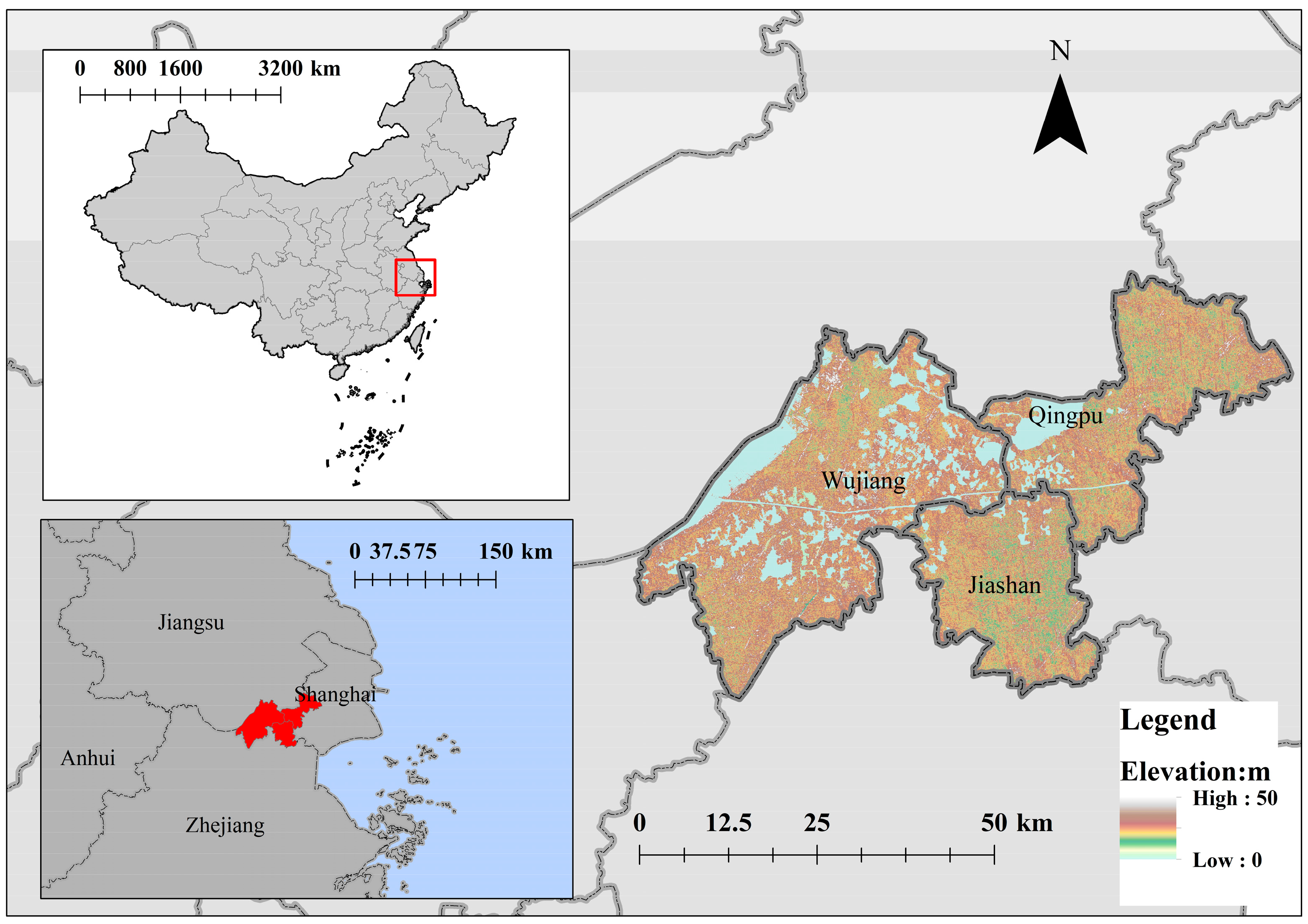
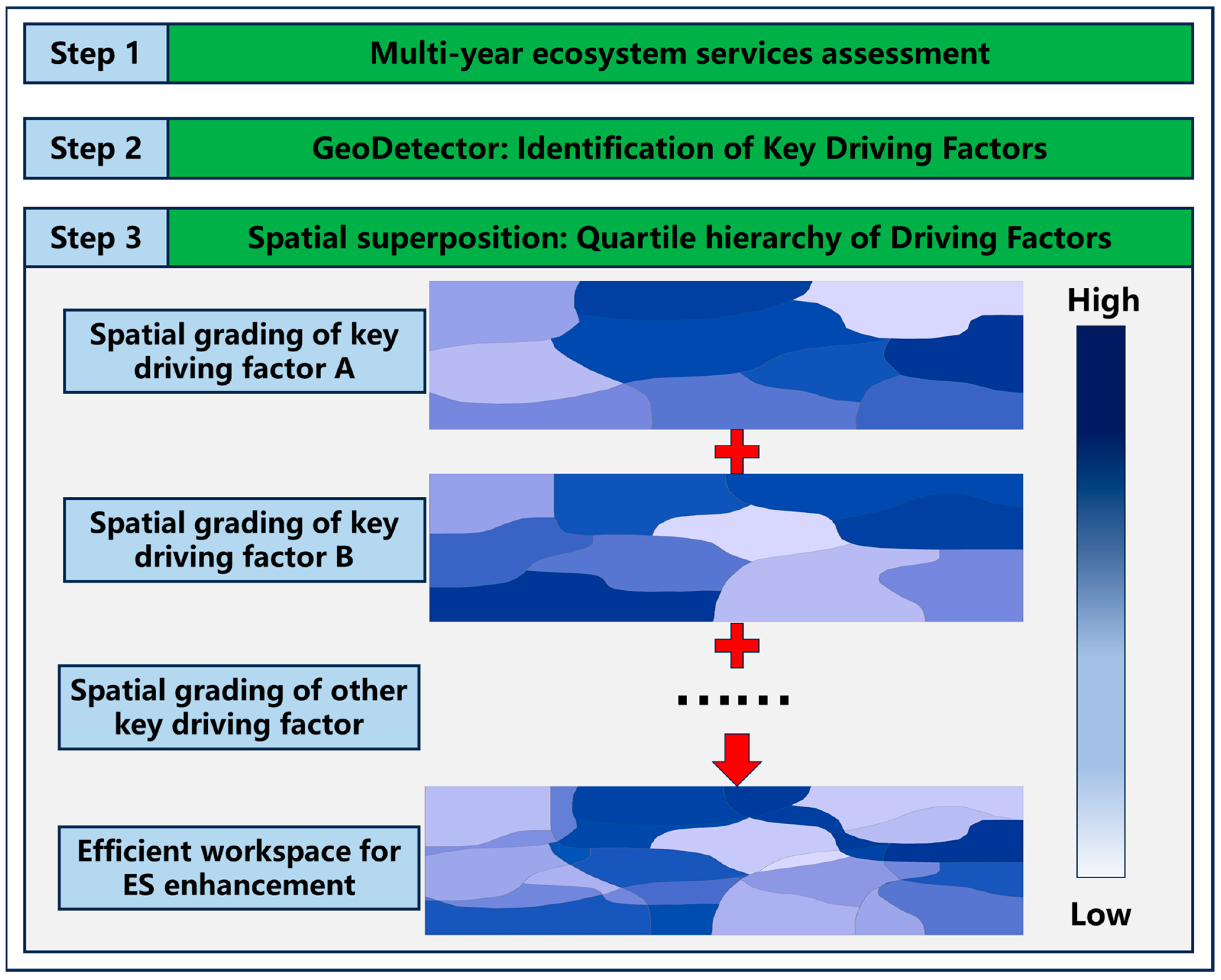
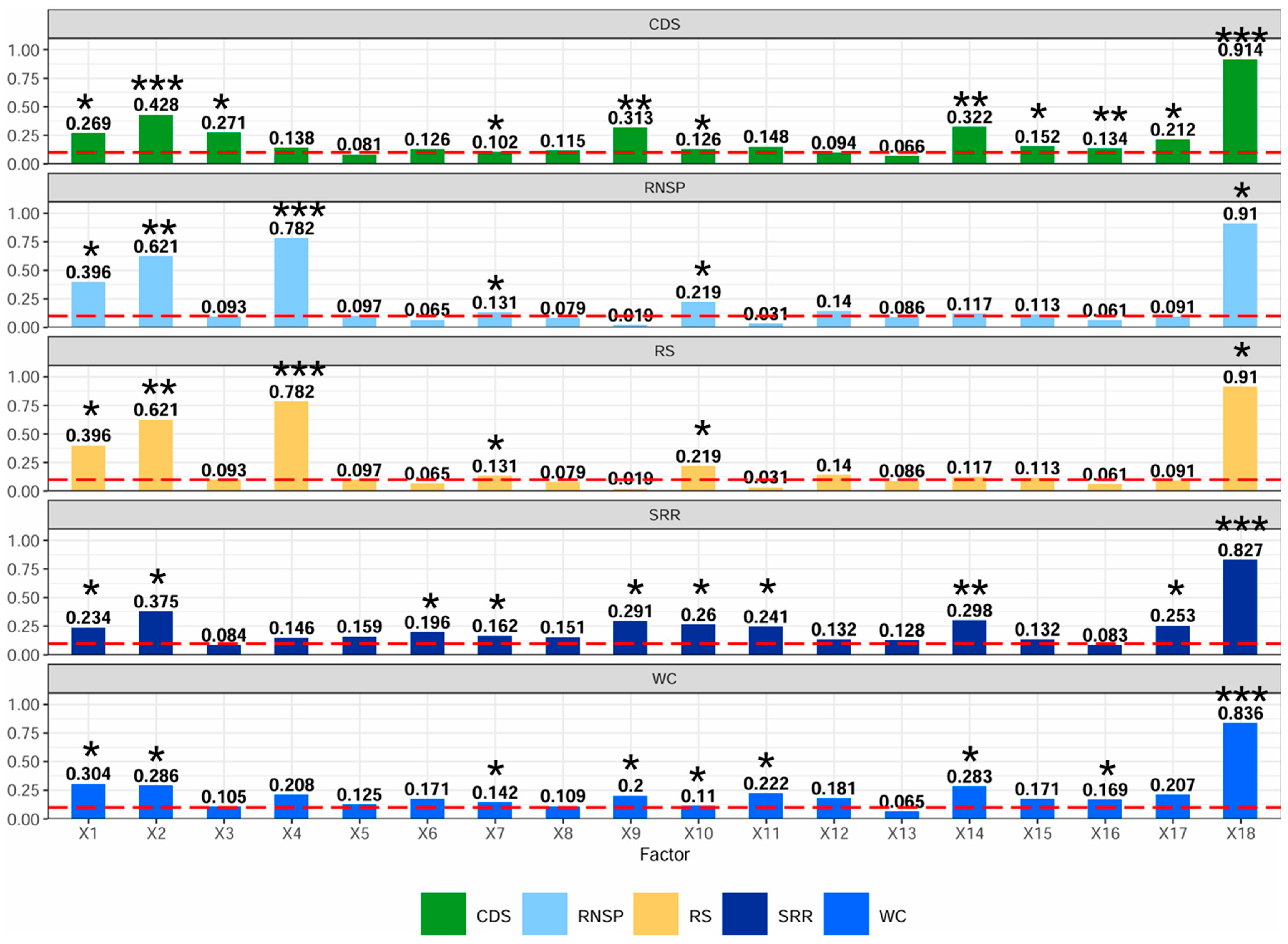
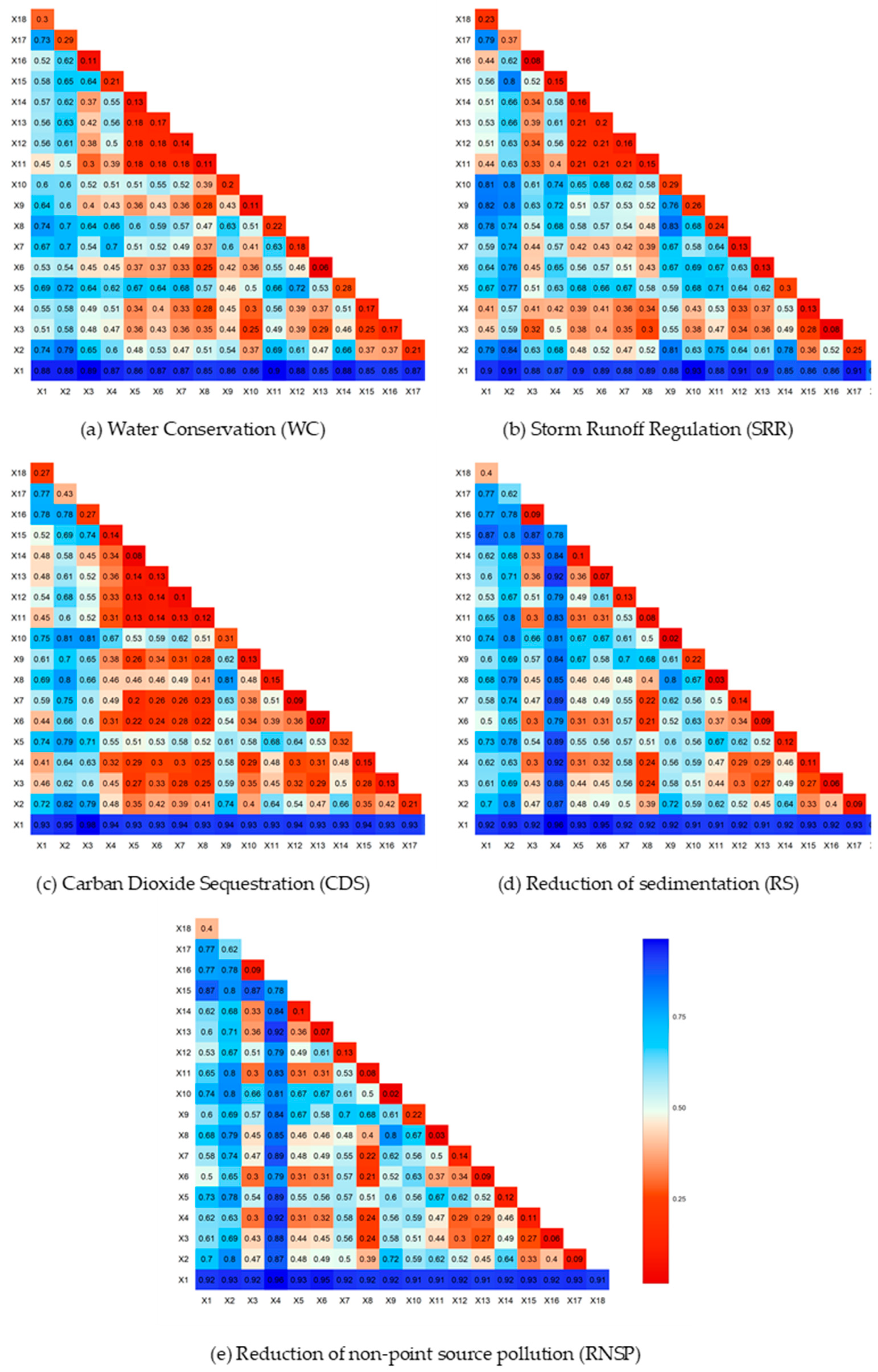
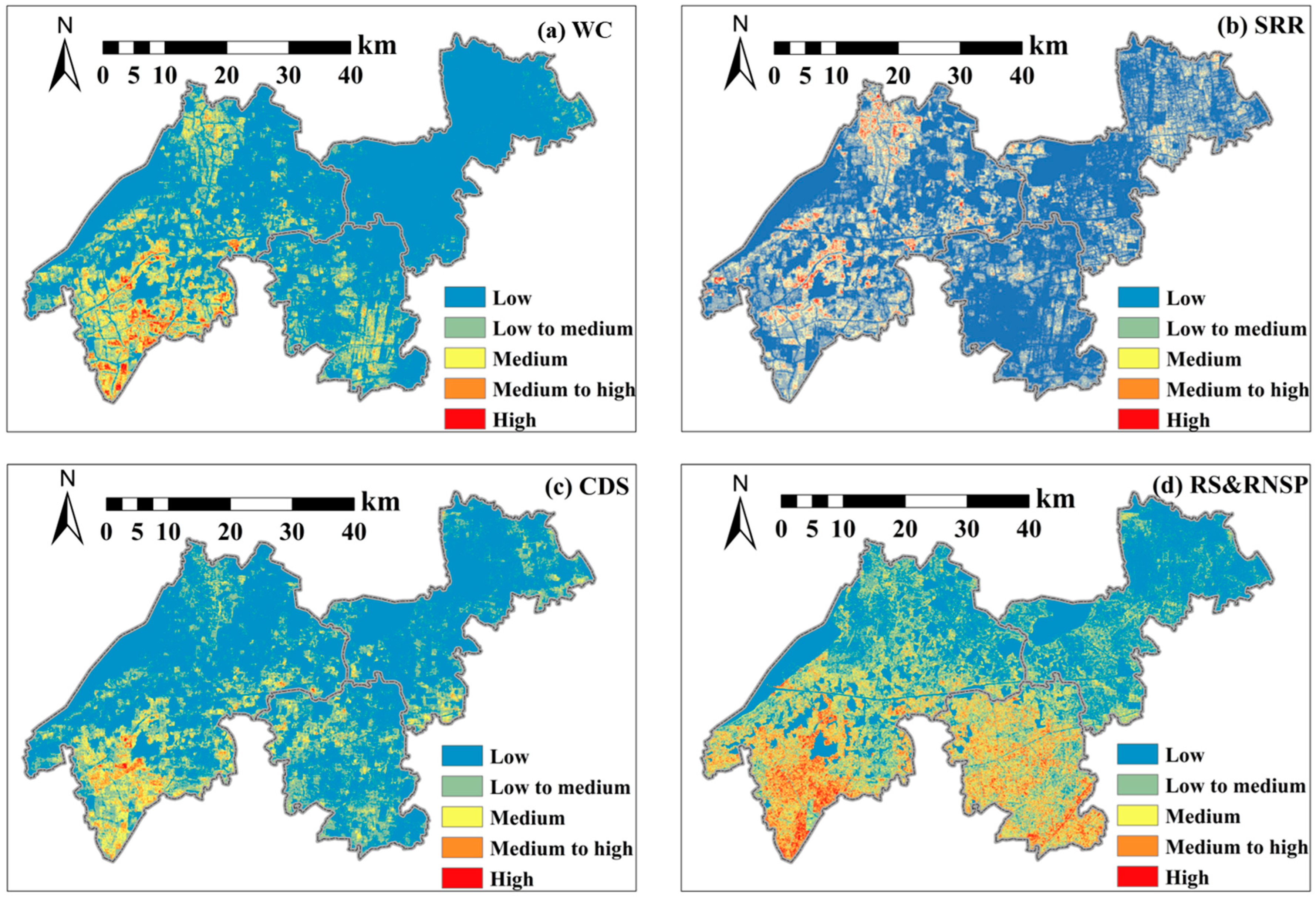
| Data | Year | Resolution | Data Type | Data Source |
|---|---|---|---|---|
| Ecosystem Classification Data | 2000, 2005, 2010, 2015, 2020 | 30 m | Raster | Chinese Academy of Sciences Resource and Environmental Data Center (https://www.resdc.cn/), accessed on 1 January 2024 |
| Daily Heavy Rainfall Standards | - | - | Text | China Meteorological Administration GB/T28592−2012, accessed on 1 January 2024 |
| Daily Rainfall Monitoring Data | 2020 | - | Excel | Chinese Academy of Sciences Resource and Environmental Data Center (https://www.resdc.cn/), accessed on 1 January 2024 |
| Soil Attributes Data (clay, sand, silt, organic matter content) | - | 1000 m | Raster | World Soil Database (https://www.fao.org/home/en/), accessed on 1 January 2024 |
| Soil Bulk Density | - | 1000 m | Raster | World Soil Database (https://www.fao.org/home/en/), accessed on 1 January 2024 |
| Ecosystem Type CN Values | - | - | Text | U.S. Department of Agriculture Natural Resources Conservation Service |
| Ecosystem Evapotranspiration Data | 2000, 2005, 2010, 2015, 2020 | 500 m | Raster | The Earth Science Data Systems (ESDS) Program (https://www.earthdata.nasa.gov/), accessed on 1 January 2024 |
| Net Primary Productivity Data | 2000, 2005, 2010, 2015, 2020 | 10 | Raster | Chinese Academy of Sciences Ecological Environment Research Center (based on MODIS annual NPP data and Sentinel-2 imagery) |
| Digital Elevation Model | - | 30 m | Raster | ASTER GDEM V3 |
| Normalized Difference Vegetation Index Data | 2000, 2005, 2010, 2015, 2020 | 10 | Raster | Chinese Academy of Sciences Resource and Environmental Data Center (https://www.resdc.cn/), accessed on 1 January 2024 |
| Code | Potential Driving Forces | Data Sources |
|---|---|---|
| X1 | DEM | ASTER GDEM V3 DEM data |
| X2 | NDVI | Chinese Academy of Sciences Resource and Environmental Data Center (https://www.resdc.cn/), accessed on 1 January 2024 |
| X3 | NPP | State Key Laboratory of Urban and Regional Ecology, Research Center for Eco-Environment Sciences, Chinese Academy of Sciences |
| X4 | Slope | Slope analysis based on ASTER GDEM V3 DEM data |
| X5 | Content of sticky particles | World Soil Database (https://www.fao.org/home/en/), accessed on 1 January 2024 |
| X6 | Content of powder particles | World Soil Database (https://www.fao.org/home/en/), accessed on 1 January 2024 |
| X7 | Content of organic matter | World Soil Database (https://www.fao.org/home/en/), accessed on 1 January 2024 |
| X8 | Content of sand particles | World Soil Database (https://www.fao.org/home/en/), accessed on 1 January 2024 |
| X9 | GDP/m2 | Chinese Academy of Sciences Resource and Environmental Data Center (https://www.resdc.cn/), accessed on 1 January 2024 |
| X10 | Precipitation | Chinese Academy of Sciences Resource and Environmental Data Center (https://www.resdc.cn/), accessed on 1 January 2024 |
| X11 | Distance from the water system | ArcGIS distance analysis based on water body extent in ecosystem classification data |
| X12 | Distance from railways | ArcGIS distance analysis based on Golder Electronic Basemap railroad data |
| X13 | Distance from major roads | ArcGIS distance analysis based on highway data from Golder Electronic Basemap |
| X14 | Population density | Chinese Academy of Sciences Resource and Environmental Data Center (https://www.resdc.cn/), accessed on 1 January 2024 |
| X15 | Average annual air humidity | Chinese Academy of Sciences Resource and Environmental Data Center (https://www.resdc.cn/), accessed on 1 January 2024 |
| X16 | Average annual temperature | Chinese Academy of Sciences Resource and Environmental Data Center (https://www.resdc.cn/), accessed on 1 January 2024 |
| X17 | Evapotranspiration | Chinese Academy of Sciences Resource and Environmental Data Center (https://www.resdc.cn/), accessed on 1 January 2024 |
| X18 | Ecosystem types | Chinese Academy of Sciences Resource and Environmental Data Center (https://www.resdc.cn/), accessed on 1 January 2024 |
Disclaimer/Publisher’s Note: The statements, opinions and data contained in all publications are solely those of the individual author(s) and contributor(s) and not of MDPI and/or the editor(s). MDPI and/or the editor(s) disclaim responsibility for any injury to people or property resulting from any ideas, methods, instructions or products referred to in the content. |
© 2024 by the authors. Licensee MDPI, Basel, Switzerland. This article is an open access article distributed under the terms and conditions of the Creative Commons Attribution (CC BY) license (https://creativecommons.org/licenses/by/4.0/).
Share and Cite
Cai, W.; Shu, C. Integrating System Perspectives to Optimize Ecosystem Service Provision in Urban Ecological Development. Systems 2024, 12, 375. https://doi.org/10.3390/systems12090375
Cai W, Shu C. Integrating System Perspectives to Optimize Ecosystem Service Provision in Urban Ecological Development. Systems. 2024; 12(9):375. https://doi.org/10.3390/systems12090375
Chicago/Turabian StyleCai, Wenbo, and Chengji Shu. 2024. "Integrating System Perspectives to Optimize Ecosystem Service Provision in Urban Ecological Development" Systems 12, no. 9: 375. https://doi.org/10.3390/systems12090375
APA StyleCai, W., & Shu, C. (2024). Integrating System Perspectives to Optimize Ecosystem Service Provision in Urban Ecological Development. Systems, 12(9), 375. https://doi.org/10.3390/systems12090375







